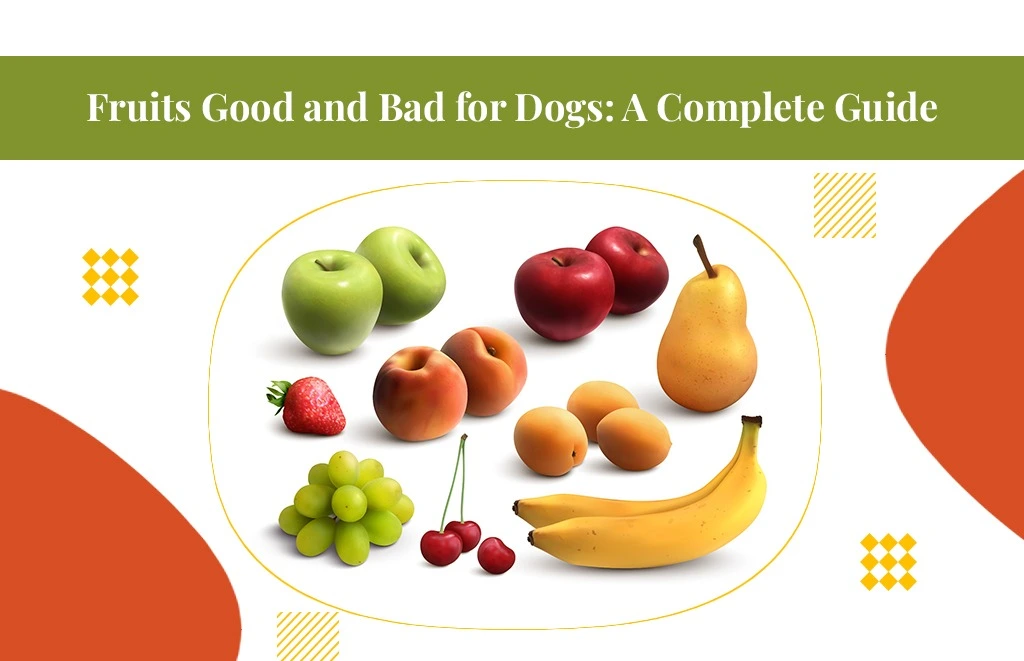Fruits Good and Bad for Dogs: A Complete Guide
Table of Contents
- Introduction
- The Benefits of Including Fruits in Your Dog’s Diet
- Safe and Dog-Friendly Fruits
- Toxic Fruits and Fruits to Avoid
- Precautions and Guidelines
- Balancing Fruits with Your Dog’s Regular Diet
- Nutritional Benefits of Dog-Friendly Fruits
- Fruits for Puppies: Tailoring Their Diet for Growth
- Homemade Fruit-Based Dog Treats: Recipes Your Pooch Will Love
- Tips and Precautions
- Seasonal Fruits for Dogs: Adapting to the Time of Year
- FAQs
- Conclusion
Introduction
Fruits are a great source of vitamins, antioxidants, and fibre for humans, but what about dogs? Can dogs eat fruits, and if so, which ones are safe and beneficial for them? In this blog post, we will answer these questions related to fruits dogs can eat and more. We will also provide some tips and precautions on introducing fruits to your dog’s diet, balancing them with their regular food, and making some homemade fruit-based treats that your pooch will love.
The Benefits of Including Fruits in Your Dog’s Diet
Fruits can offer many health benefits for dogs, as they contain various nutrients supporting their immune system, digestion, skin, and coat. Some of the benefits of fruits for dogs are:
- They can provide natural sugars that can boost their energy levels and mood.
- They can help prevent or treat constipation, diarrhoea, and other digestive issues, as they are rich in fibre and water.
- They can help fight inflammation, oxidative stress, and infections, as they contain antioxidants and phytochemicals.
- Because they are low in fat and sodium, they can help lower cholesterol, blood pressure, and blood sugar levels.
- They can help prevent or manage obesity, diabetes, and other metabolic disorders, as they are low in calories and can promote satiety.
- They can help improve their skin and coat condition, as they contain vitamins A, C, E, and K and minerals like zinc and copper.
However, not all fruits are equally beneficial for dogs. Some fruits are more suitable than others, depending on their nutritional profile, taste, texture, and potential risks. In the next section, we will explore which fruits are safe and dog-friendly and which are toxic or should be avoided.
Safe and Dog-Friendly Fruits
According to the American Kennel Club, the following fruits are safe and suitable for dogs to eat in moderation:
- Apples:
Apples are a good source of vitamin C, calcium, phosphorus, and fibre. They can also aid in cleaning your dog’s teeth and freshen their breath. However, you should always remove the seeds and core before giving them to your dog, as they contain cyanide that can be harmful in large amounts.
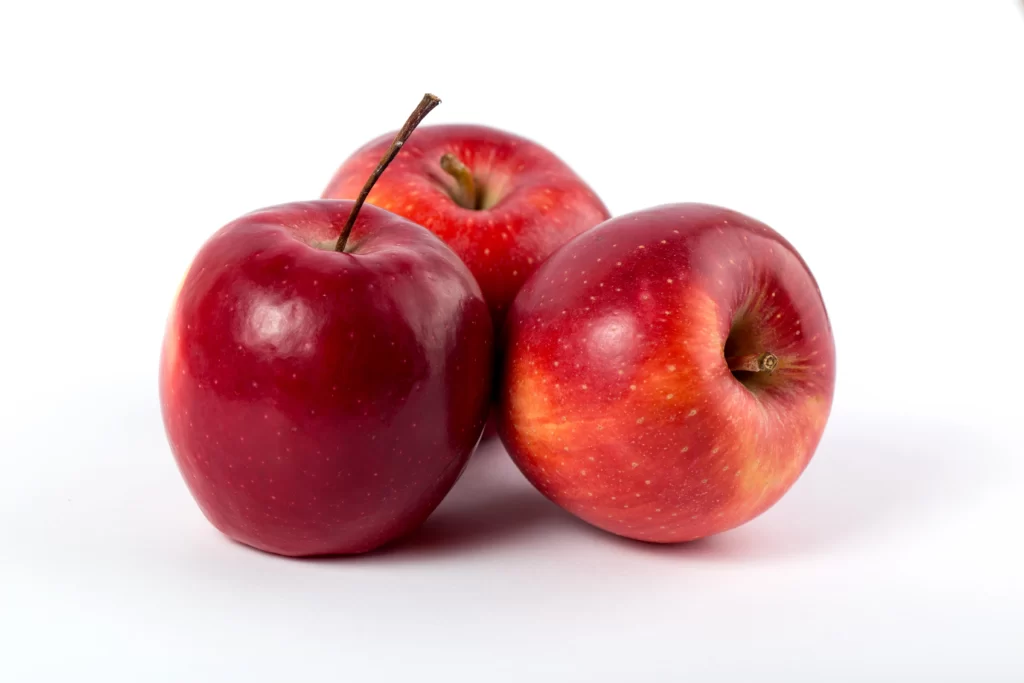
- Bananas:
Bananas are rich in potassium, biotin, vitamins B6 and C, fibre, and copper. They can also help soothe an upset stomach or diarrhoea. However, they are also high in sugar and calories, so you should only give them in small amounts as an occasional treat.
- Blueberries:
Fruits dogs can eat includes blueberries. They are a superfood packed with antioxidants, vitamins C and K, fibre, and manganese. They can help protect your dog from oxidative damage, inflammation, and infections. They are also low in calories and sugar, so you can give them more frequently than other fruits.
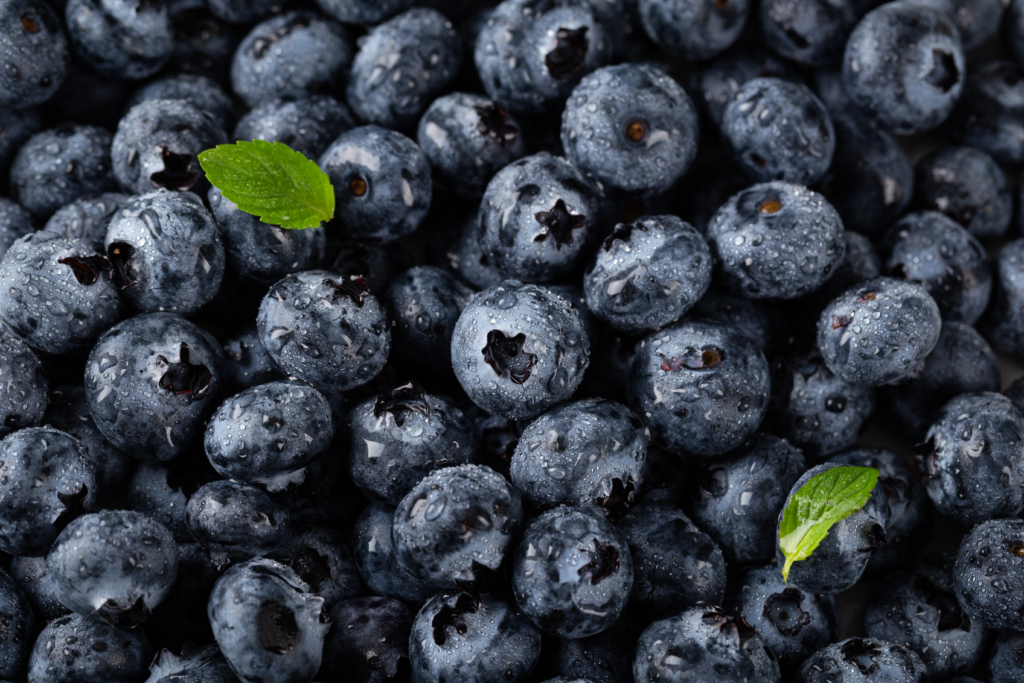
- Strawberries:
Strawberries are another antioxidant-rich fruit that can boost your dog’s immune system. They also contain vitamin C, fibre, potassium, magnesium, and folic acid. They can also help whiten your dog’s teeth naturally. However, they are also high in sugar, so you should limit the amount you give to your dog.
- Watermelon:
Watermelon is a refreshing fruit that can hydrate your dog on a hot day. It is mostly water but contains vitamins A, C, potassium, and lycopene. It can help prevent dehydration, heat stroke, and urinary tract infections. However, you should remove the seeds and rind before giving it to your dog, as they can cause intestinal blockage or choking.
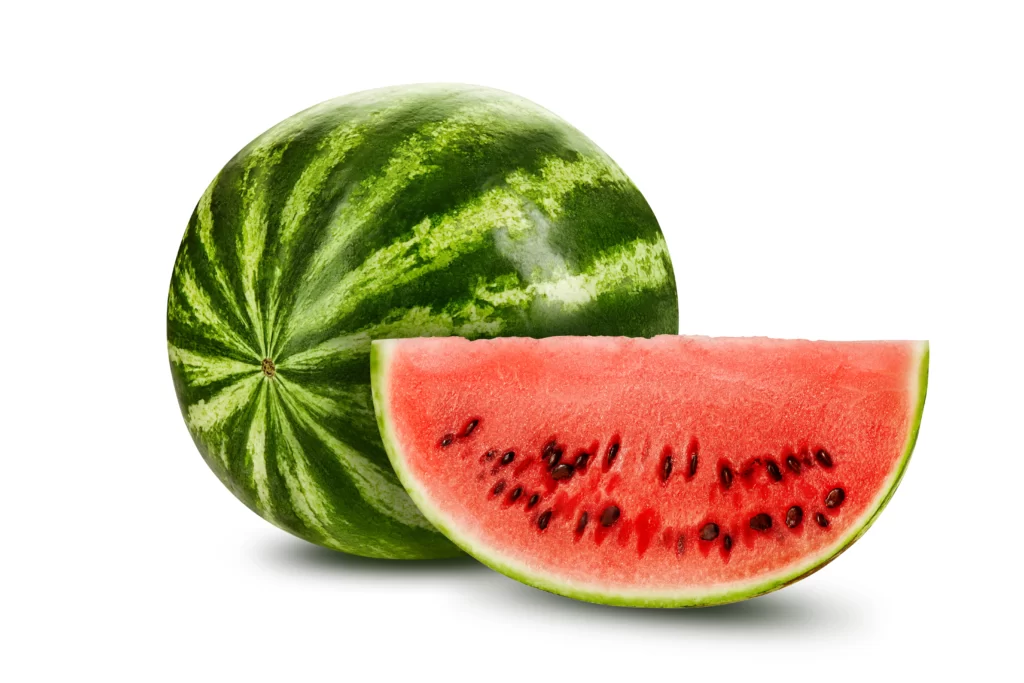
- Cantaloupe:
Cantaloupe is another hydrating fruit that is high in water content. It also contains vitamins A and C, beta-carotene, fibre, and potassium. It can help improve your dog’s vision, skin, and coat health. However, it is also high in sugar, so you should only give it in small amounts as an occasional treat.
- Pineapple:
Pineapple is a tropical fruit rich in vitamin C, manganese, copper, fibre, and bromelain. Bromelain is an enzyme that can help digest proteins and reduce inflammation. It can also help prevent or treat worms in your dog’s intestines. However, pineapple is also high in sugar and acidity, so you should only give it in small amounts as an occasional treat.
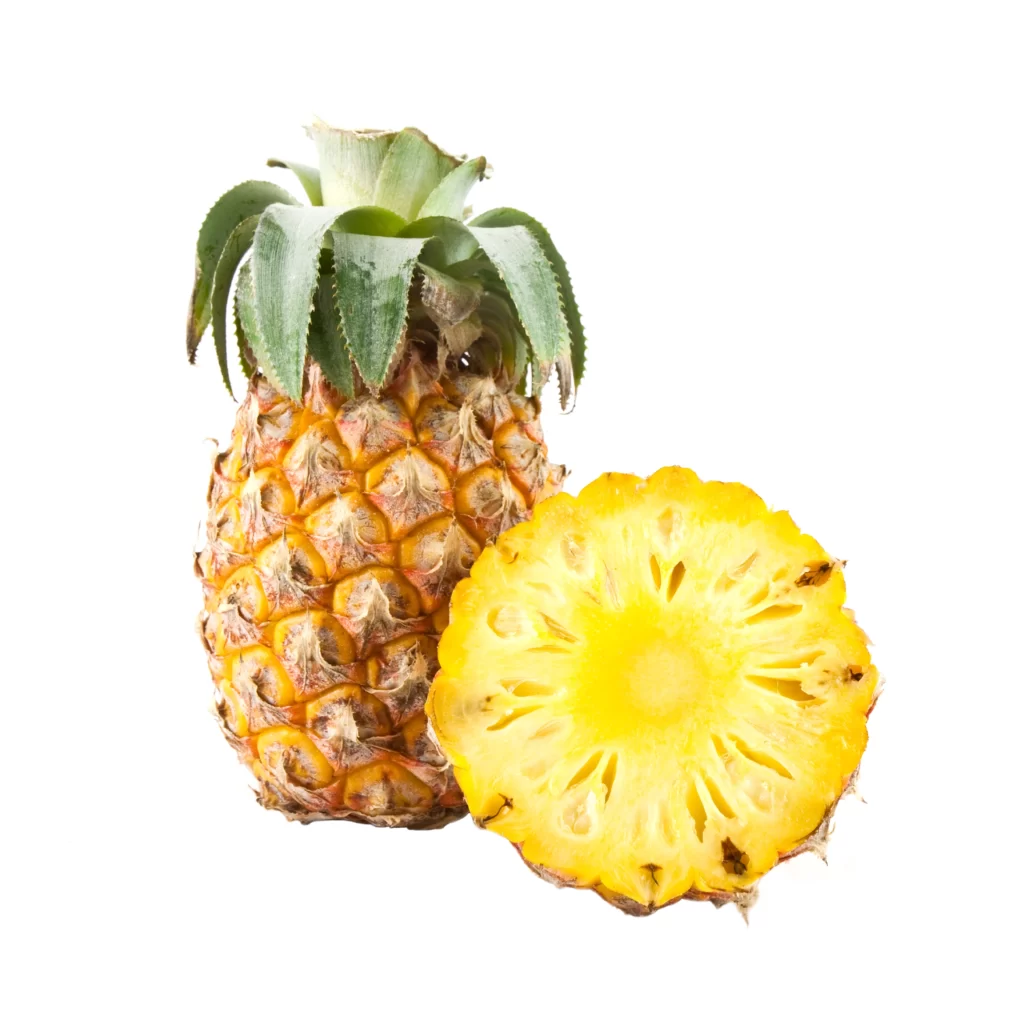
- Mango:
Mango is another tropical fruit with vitamins A, C, E, K, potassium, magnesium, and antioxidants. It can help boost your dog’s immune system and skin health. However, mango is also high in sugar and calories, so you should only give it in small amounts as an occasional treat. You should also remove the pit before giving it to your dog, as it can cause choking or intestinal blockage.
- Pears:
Pears are a good source of vitamin C, vitamin K, copper, and fibre. They can also help reduce your dog’s blood pressure and cholesterol levels. However, you should always remove the seeds and core before giving them to your dog, as they contain cyanide that can be harmful in large amounts.
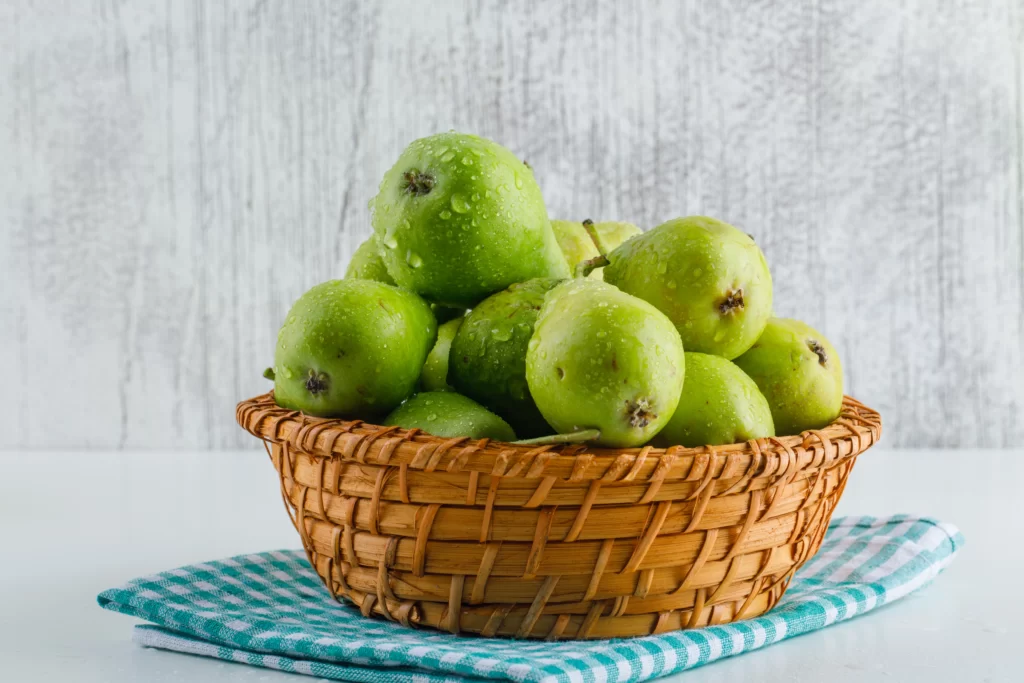
- Oranges:
Oranges are citrus fruits high in vitamin C, potassium, folate, and fibre. They can guard against scurvy and strengthen your dog’s immune system. However, oranges are also high in sugar and acidity, so you should only give them in small amounts as an occasional treat. You should also remove the peel and seeds before giving them to your dog, as they can cause digestive upset or choking.
- Peaches:
Peaches are juicy fruits with vitamins A, C, potassium, and fibre. They can help improve your dog’s skin and coat health and prevent infections. However, peaches are also high in sugar and calories, so you should only give them in small amounts as an occasional treat. You should also remove the pit before giving it to your dog, as it can cause choking or intestinal blockage.
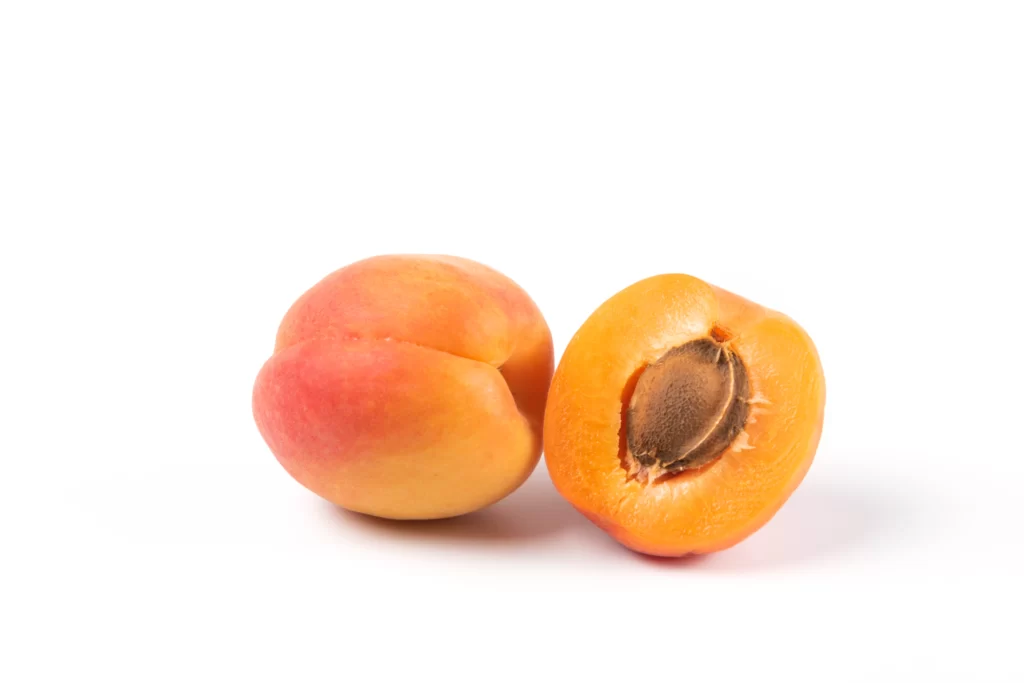
Toxic Fruits and Fruits to Avoid
The following fruits are toxic or dangerous for dogs and should be avoided at all costs:
- Grapes and raisins:
Grapes and raisins are among the most toxic fruits for dogs, as they can cause acute kidney failure, even in small amounts. The exact reason for toxicity is unknown, but it affects some dogs more than others. Grape or raisin poisoning symptoms include vomiting, diarrhoea, lethargy, dehydration, decreased urine output, and kidney failure. Contact your vet immediately if your dog has ingested grapes or raisins.
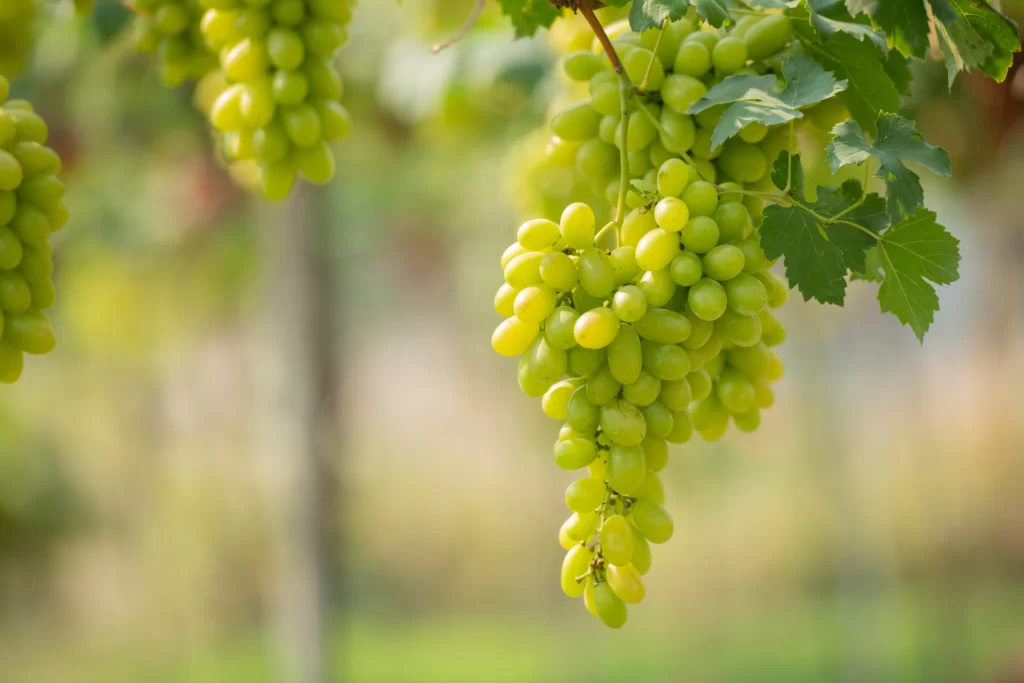
- Avocado:
Avocado contains a toxin called persin, which, if ingested, can cause vomiting, diarrhoea, respiratory distress, and heart problems in dogs. The toxin is present in all parts of the avocado plant, including the fruit, seed, skin, and leaves. The seed can also cause choking or intestinal blockage if swallowed by your dog. Therefore, you should never give avocados to your dog or let them near any avocado plants.
- Cherries:
Cherries contain cyanide, which can interfere with your dog’s cellular oxygen transport and cause breathing difficulties, weakness, collapse, and death. The cyanide is present in the cherry pits, stems, and leaves but not in the fruit’s flesh. However, the pits can also cause choking or intestinal blockage if swallowed by your dog. Therefore, you should never give cherries to your dog or let them near any cherry plants.
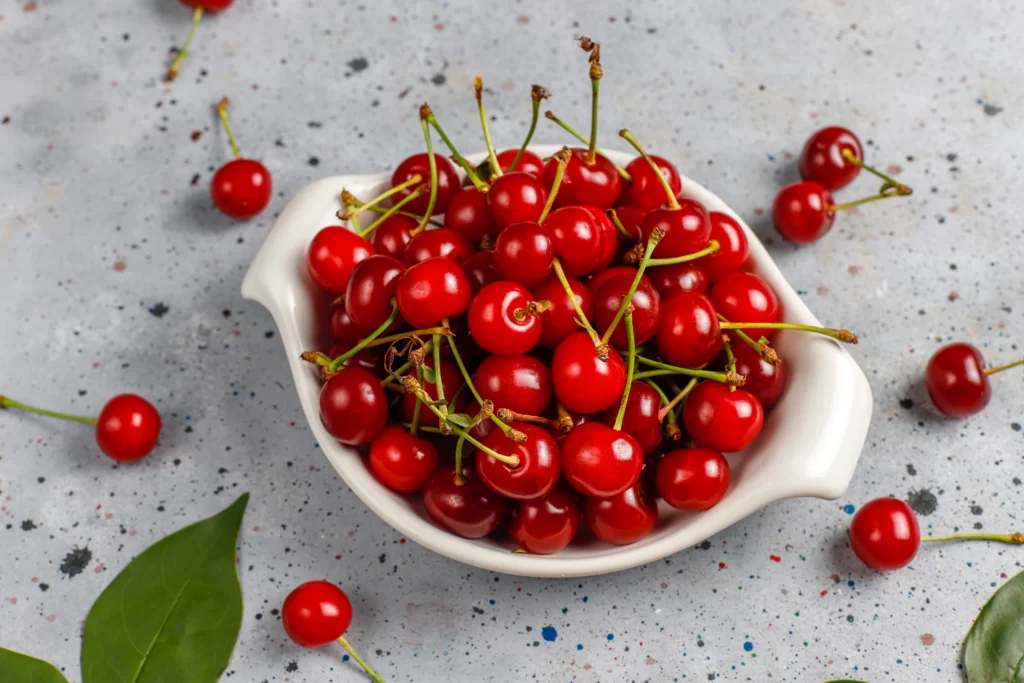
- Plums:
Plums are similar to cherries as they contain cyanide in their pits, stems, and leaves. The flesh of the fruit is not toxic, but the pits can cause choking or intestinal blockage if swallowed by your dog. Therefore, you should never give plums to your dog or let them near any plum plants.
- Apricots:
Apricots are similar to cherries and plums as they contain cyanide in their pits, stems, and leaves. The flesh of the fruit is not toxic, but the pits can cause choking or intestinal blockage if swallowed by your dog. Therefore, you should never give apricots to your dog or let them near any apricot plants.
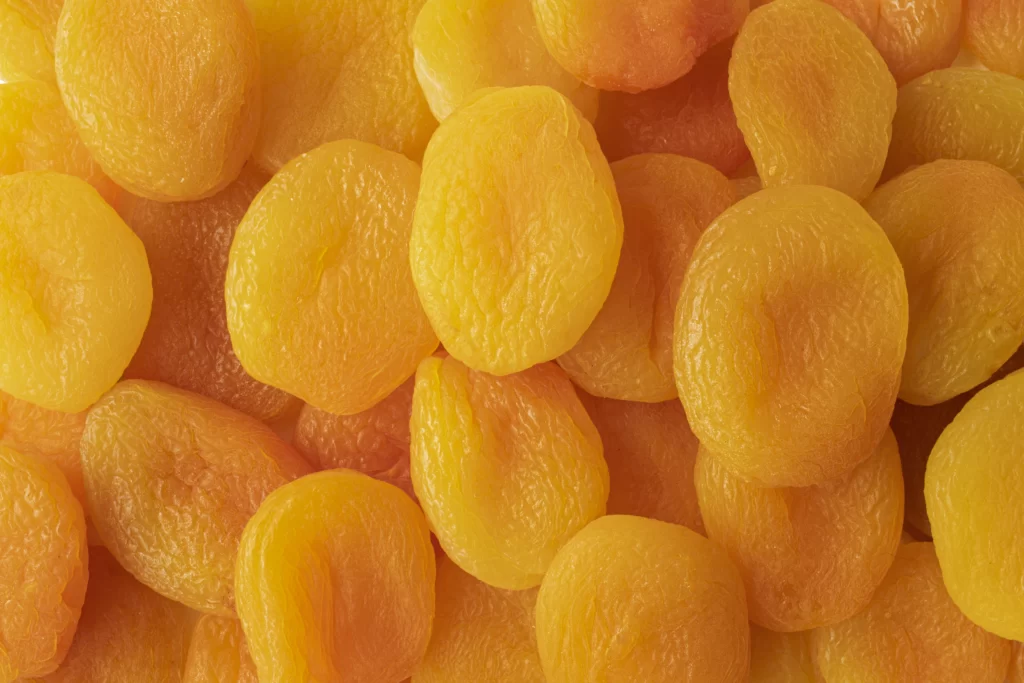
- Persimmons:
Persimmons are a type of fruit that has a large seed inside that can cause choking or intestinal blockage if swallowed by your dog. The seed can also irritate your dog’s intestines and cause inflammation or infection. Therefore, you should never give persimmons to your dog or let them near any persimmon plants.
- Tomatoes:
Tomatoes are technically a fruit but belong to the nightshade family of plants, which contain a toxin called solanine. Solanine can cause gastrointestinal upset, cardiac arrhythmias, seizures, and death in dogs. The toxin is present in higher concentrations in the green parts of the tomato plant, such as the stem, the leaves, and the unripe fruit. The ripe red fruit is less toxic but can still cause digestion issues in some dogs. Therefore, you should avoid giving your dog tomatoes or letting them near any tomato plants.
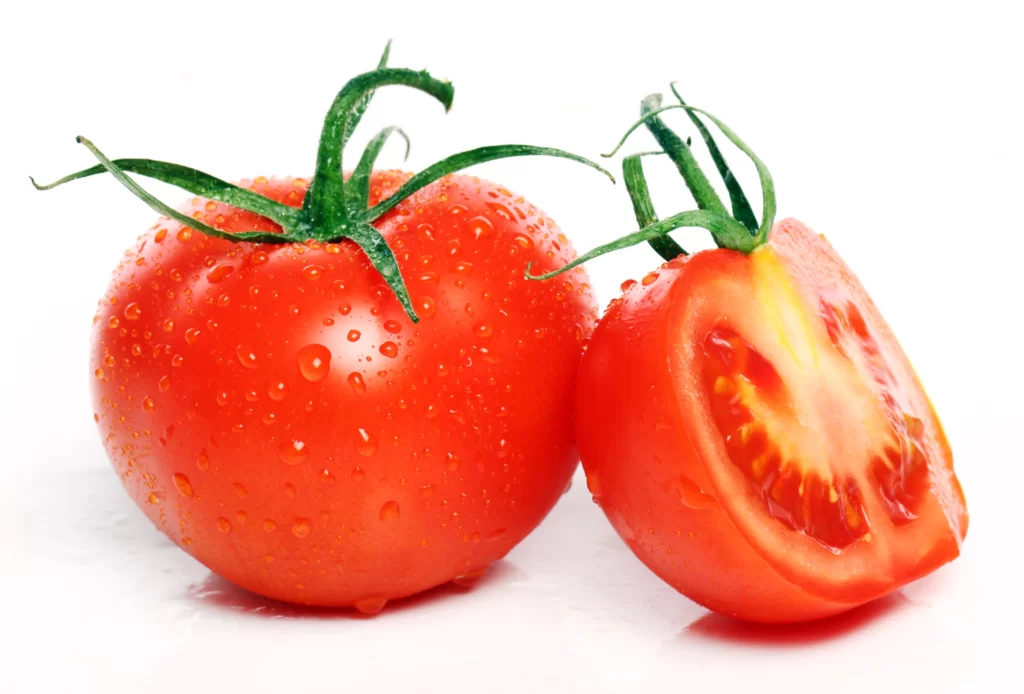
- Rhubarb:
Rhubarb is a type of vegetable that has a sour taste and a crunchy texture. However, it also contains oxalic acid, which can cause kidney damage, tremors, seizures, and death in dogs. The oxalic acid is present in higher concentrations in the leaves of the rhubarb plant, but it can also be found in the stalks. Therefore, you should never give rhubarb to your dog or let them near any rhubarb plants.
- Figs:
Figs are a fruit with a sweet taste and a soft texture. However, they also contain ficin and ficusin, which can cause allergic reactions, skin irritation, oral inflammation, and vomiting in dogs. The ficin and ficusin are present in the sap of the fig plant, which can leak from the fruit when it is ripe or damaged. Therefore, you should never give figs to your dog or let them near any fig plants.
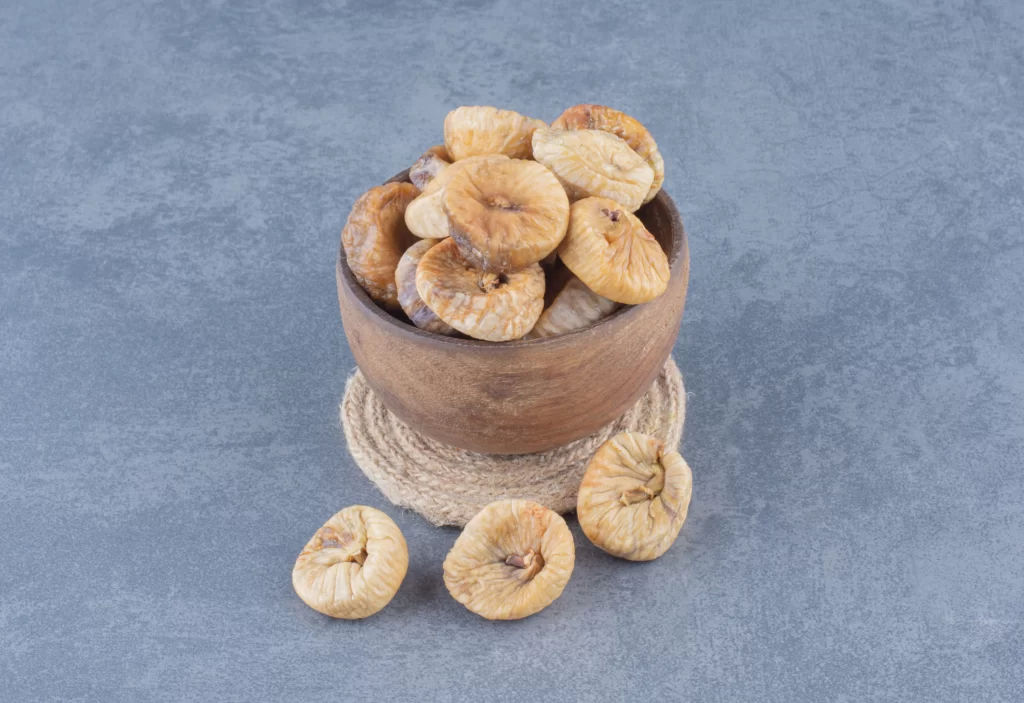
Precautions and Guidelines
Before giving any fruits to your dog, you should always follow these precautions and guidelines:
- Consult your veterinarian:
Your veterinarian knows your dog’s health history, allergies, and dietary needs better than anyone else. They can advise you on which fruits are safe and beneficial for your dog and which are toxic or harmful. They can also tell you how much and how often you can give fruits to your dog, depending on their age, weight, breed, and activity level.
- Wash the fruits:
Fruits can be contaminated with pesticides, herbicides, fungicides, bacteria, parasites, and other harmful substances that can affect your dog’s health. Therefore, you should always wash the fruits thoroughly before giving them to your dog. You can use water, vinegar, or a fruit and vegetable wash to remove any dirt or residue from the fruits.
- Cut the fruits:
Fruits can be too large or hard for your dog to chew or swallow. Therefore, you should always cut the fruits into small pieces appropriate for your dog’s size and mouth. You should also remove any seeds, pits, cores, stems, leaves, peels, or rinds that can pose a choking or intestinal blockage hazard for your dog.
- Introduce the fruits gradually:
Fruits can cause digestive upset or allergic reactions in some dogs if they are not used to them. Therefore, you should introduce the fruits gradually to your dog’s diet. Start with a small amount of one fruit at a time and observe your dog’s reaction. If they show any signs of discomfort or distress, such as vomiting, diarrhoea, gas, bloating, itching, or hives. If you notice these symptoms, stop giving them the fruit, and contact your veterinarian. If your dog shows no discomfort or distress, you can proceed to the next step.
- Increase the amount and frequency:
Gradually increase the amount and frequency of giving the same fruit to your dog. For example, you can feed your dog two slices of apple or two blueberries the next day and then three slices or three blueberries the day after. However, as explained in the previous section, you should stay within the 10% rule of thumb for fruits. You should also avoid giving fruits to your dog right before or after their meals, as this can cause digestive problems or nutrient imbalances.
- Introduce another fruit:
Once your dog is used to one fruit, you can introduce another safe and dog-friendly fruit. Follow the same steps as above for washing, cutting, giving, waiting, and watching. You can also mix different fruits to create a fruit salad for your dog, as long as they are compatible and not too acidic or sugary.
- Enjoy the benefits:
By introducing fruits to your dog’s diet, you can enjoy the benefits of providing them with natural sugars, vitamins, antioxidants, and fibre. You can also use fruits as a reward or a treat for your dog’s good behaviour or training. Fruits can also help improve your dog’s mood, energy levels, and skin and coat condition.
Balancing Fruits with Your Dog’s Regular Diet
Fruits are not a substitute for your dog’s regular food but a supplement or a treat. Therefore, you should balance fruits with your dog’s regular diet to ensure they get all the nutrients they need for their health and well-being. Here are some tips on how to balance fruits with your dog’s regular diet:
- Choose a high-quality dog food:
Your dog’s regular food should be high-quality and complete, meaning it contains all the essential nutrients it needs in proportions. You should choose a dog food appropriate for your dog’s age, weight, breed, and activity level. You should also consult your veterinarian for any specific dietary recommendations or restrictions for your dog.
- Follow the feeding instructions:
Your dog’s regular food should come with instructions that tell you how much and how often you should feed your dog. You should follow these instructions carefully and measure your dog’s food accurately. You should also adjust your dog’s food intake according to their activity level, health condition, and weight goals.
- Reduce the amount of regular food:
If you give fruits to your dog as a supplement or a treat, you should reduce the amount of regular food you give them accordingly. This will prevent overfeeding and obesity in your dog. As a general rule, you should reduce the amount of regular food by 10% for every 10% of fruits you give to your dog. For example, if you give your dog 50 grams of fruit, you should also reduce their regular food by 50 grams.
- Monitor your dog’s weight:
You should monitor your dog’s weight regularly to ensure they are not gaining or losing too much weight. You can use a scale, a measuring tape, or a body condition score to check your dog’s weight. You should also consult your veterinarian for the ideal weight range for your dog. If your dog is overweight or underweight, you should adjust their food intake accordingly.
- Provide fresh water:
You should always provide fresh and clean water for your dog, especially if you give them fruits. Fruits can increase your dog’s water intake and urine output, affecting their hydration and electrolyte balance. Therefore, you should always ensure your dog has access to water and encourage them to drink more. You should also check your dog’s urine for changes in colour, odour, or frequency. If you notice any signs of dehydration or urinary problems in your dog, contact your veterinarian immediately.
Nutritional Benefits of Dog-Friendly Fruits
Fruits can provide various nutritional benefits for dogs, as they contain different nutrients supporting their health and well-being. Here are some of the dietary benefits of dog-friendly fruits:
- Vitamin A:
Vitamin A is a fat-soluble vitamin essential for your dog’s vision, skin, coat, and immune system. It can also help prevent or treat eye infections, dry eyes, night blindness, and skin disorders in your dog. Some fruits high in vitamin A are cantaloupe, mango, peach, and watermelon.
- Vitamin C:
Vitamin C is a water-soluble vitamin essential for your dog’s immune system, wound healing, and collagen synthesis. It can also help prevent or treat scurvy, infections, inflammation, and oxidative stress in your dog. Some fruits high in vitamin C are orange, pineapple, strawberry, and blueberry.
- Vitamin E:
Vitamin E is a fat-soluble vitamin vital for your dog’s skin, coat, and reproductive system. It can also help prevent or treat skin problems, hair loss, infertility, and muscle weakness in your dog. Some fruits high in vitamin E are mango, kiwi, and apricot.
- Vitamin K:
Vitamin K is a fat-soluble vitamin essential for your dog’s blood clotting, bone health, and metabolism. It can also help prevent or treat your dog’s bleeding disorders, osteoporosis, and liver problems. Some fruits high in vitamin K are blueberry, pear, and kiwi.
- Calcium:
Calcium is a mineral crucial for your dog’s bone and teeth development, muscle contraction, nerve transmission, and blood coagulation. It can also help prevent or treat rickets, osteomalacia, and hypocalcemia in your dog. Some fruits high in calcium are orange, strawberry, and cantaloupe.
- Phosphorus:
Phosphorus is a mineral that is important for your dog’s bone and teeth formation, energy production, and acid-base balance. It can also help prevent or treat bone disorders, kidney stones, and hypophosphatemia in your dog. Some fruits that are high in phosphorus include bananas, peaches, and watermelon.
- Potassium:
Potassium is essential for your dog’s fluid balance, nerve function, and muscle activity. It can also help prevent or treat dehydration, hypokalemia, and cardiac arrhythmias in your dog. Some fruits high in potassium are bananas, cantaloupe, and mango.
- Magnesium:
Magnesium is a mineral that is essential for your dog’s enzyme function, muscle relaxation, and nerve transmission. It can also help prevent or treat your dog’s muscle cramps, tremors, seizures, and hypomagnesemia. Some fruits that are high in magnesium are banana, pineapple, and strawberry.
- Manganese:
Manganese is a mineral necessary for your dog’s bone and cartilage formation, glucose metabolism, and antioxidant defence. It can also help prevent or treat skeletal abnormalities, diabetes, and manganese deficiency in your dog. Some fruits high in manganese are pineapple, strawberry, and blueberry.
- Copper:
Copper is an essential mineral for your dog’s red blood cell production, iron absorption, pigment synthesis, and immune function. It can also help prevent or treat anaemia, depigmentation, and copper deficiency in your dog. Some fruits that are high in copper are mango, kiwi, and pear.
- Zinc:
Zinc is a mineral that is essential for your dog’s skin and coat health, wound healing, and immune system. It can also help prevent or treat skin problems, hair loss, infections, and zinc deficiency in your dog. Some fruits that are high in zinc are blueberries, peaches, and apricots.
- Fibre:
Fibre is a carbohydrate that is indigestible by your dog’s body but beneficial for their digestion and bowel movements. It can also help prevent or treat constipation, diarrhoea, obesity, diabetes, and colon cancer in your dog. Some fruits that are high in fibre are apple, pear, and banana.
- Antioxidants:
Antioxidants are substances that can protect your dog’s cells from oxidative damage caused by free radicals. Free radicals are unstable molecules that can lead to inflammation, ageing, and diseases in your dog. Antioxidants can help prevent or treat oxidative stress, inflammation, infections, and cancer in your dog. Some fruits high in antioxidants are blueberry, strawberry, and orange.
- Phytochemicals:
Phytochemicals are compounds plants produce to protect themselves from pests, diseases, and environmental stress. Some phytochemicals can also benefit your dog’s health, such as anti-inflammatory, anti-microbial, anti-cancer, and anti-diabetic properties. Some phytochemicals found in fruits are flavonoids, carotenoids, polyphenols, and glucosinolates. Some fruits that are high in phytochemicals are blueberries, oranges, and pineapple.
- As you can see, fruits can offer various nutritional benefits for your dog as long as they are given in moderation and with caution. Fruits can complement your dog’s regular diet and provide them with natural sugars, vitamins, antioxidants, and fibre. However, you should always consult your veterinarian before giving any fruits to your dog and follow the precautions and guidelines discussed in this blog post. By doing so, you can ensure that your dog enjoys the fruits of your love and care.
Fruits for Puppies: Tailoring Their Diet for Growth
Puppies grow fast and need a balanced and nutritious diet to support their health and well-being. While fruits are not a necessary part of a puppy’s diet, they can provide some benefits, such as occasional treats or supplements. However, not all fruits are safe or suitable for puppies, and they should be given with caution and moderation. Here are some tips on how to tailor fruits for your puppy’s diet for growth:
- Choose fruits that are safe and dog-friendly:
As discussed in the previous sections, some fruits are toxic or dangerous for dogs and should be avoided at all costs. Some of the safe and beneficial fruits for dogs are apples, bananas, blueberries, cantaloupe, cranberries, cucumbers, mangoes, oranges, peaches, pears, pineapples, strawberries, and watermelon. However, you should always consult your veterinarian before giving any fruits to your puppy, as they may have specific dietary recommendations or restrictions for them.
- Wash and cut the fruits:
Fruits can be contaminated with pesticides, herbicides, fungicides, bacteria, parasites, and other harmful substances that can affect your puppy’s health. Therefore, you should always wash the fruits thoroughly before giving them to your puppy. You should also cut the fruits into small pieces appropriate for your puppy’s size and mouth. You should also remove any seeds, pits, cores, stems, leaves, peels, or rinds that can pose a choking or intestinal blockage hazard for your puppy.
- Give a small amount:
Puppies have smaller stomachs and digestive systems than adult dogs, and they can easily get upset by too much or too new foods. Therefore, you should only give your puppy a small amount of fruit as a treat or supplement. For example, you can provide your puppy one slice of apple or blueberry. Observe your puppy’s reaction and see if they like the taste and texture of the fruit.
- Wait and watch:
Wait 24 hours before giving your puppy another piece of the same fruit. Watch for any signs of discomfort or distress in your puppy, such as vomiting, diarrhoea, gas, bloating, itching, or hives. If you notice these symptoms, stop giving them the fruit, and contact your veterinarian. You can proceed to the next step if your puppy shows no discomfort or distress.
- Increase the amount and frequency:
Gradually increase the amount and frequency of giving the same fruit to your puppy. For example, you can give your puppy two slices of apple or two blueberries the next day and then three slices or three blueberries the day after. However, as explained in the previous section, you should stay within the 10% rule of thumb for fruits. You should also avoid giving fruits to your puppy right before or after their meals, as this can cause digestive problems or nutrient imbalances.
- Introduce another fruit:
Once your puppy is used to one fruit, you can introduce another safe and dog-friendly fruit. Follow the same steps as above for washing, cutting, giving, waiting, and watching. You can also mix different fruits to create a fruit salad for your puppy, as long as they are compatible and not too acidic or sugary.
- Enjoy the benefits:
By introducing fruits to your puppy’s diet, you can enjoy the benefits of providing them with natural sugars, vitamins, antioxidants, and fibre. You can also use fruits as a reward or a treat for your puppy’s good behaviour or training. Fruits can also help improve your puppy’s mood and energy levels and their skin and coat condition.
Fruits are a healthy and tasty addition to your puppy’s diet if given in moderation and with caution. Fruits can complement your puppy’s regular food and provide them with natural sugars, vitamins, antioxidants, and fibre. However, you should always consult your veterinarian before giving any fruits to your puppy and follow the precautions and guidelines we discussed in this blog post. By doing so, you can ensure that your puppy enjoys the fruits of your love and care.
Homemade Fruit-Based Dog Treats: Recipes Your Pooch Will Love
If you want to spoil your furry friend with some delicious and nutritious treats, why not try making some homemade fruit-based dog treats? Fruits are an excellent source of natural sugars, vitamins, antioxidants, and fibre for your dog, and they can also add some variety and flavour to their diet. However, not all fruits are safe or suitable for dogs. Hence, you must follow some guidelines when choosing and preparing fruits for your dog. In this blog post, we will share some tips and precautions on how to make homemade fruit-based dog treats, as well as some recipes that your pooch will love.
Tips and Precautions
Before making any homemade fruit-based dog treats, you should always follow these tips and precautions:
- Consult Your Veterinarian:
Your veterinarian knows your dog’s health history, allergies, and dietary needs better than anyone else. They can advise you on which fruits are safe and beneficial for your dog and which are toxic or harmful. They can also tell you how much and how often you can give fruits to your dog, depending on their age, weight, breed, and activity level.
- Wash the Fruits:
Fruits can be contaminated with pesticides, herbicides, fungicides, bacteria, parasites, and other harmful substances that can affect your dog’s health. Therefore, always wash the fruits thoroughly before using them in homemade fruit-based dog treats. You can use water, vinegar, or a fruit and vegetable wash to remove any dirt or residue from the fruits.
- Cut the fruits:
Fruits can be too large or hard for your dog to chew or swallow. Therefore, you should always cut the fruits into small pieces appropriate for your dog’s size and mouth. You should also remove any seeds, pits, cores, stems, leaves, peels, or rinds that can pose a choking or intestinal blockage hazard for your dog.
- Bake or dehydrate the fruits:
Baking or dehydrating the fruits can help preserve their nutrients, flavour, and shelf life. It can also make them easier to digest and store for your dog. You can use an oven, a microwave, or a dehydrator to bake or dehydrate the fruits. You should follow the instructions and recipes for each fruit and device, as they may vary in temperature, time, and thickness. You should also check the fruits regularly to prevent burning or over-drying them.
- Store the fruits:
Once the fruits are baked or dehydrated, let them cool completely before storing them. You can use an airtight container, a zip-lock bag, or a glass jar to store the fruits. You should keep them in a cool and dry place, away from direct sunlight and moisture. It would be best if you also labelled them with the date and name of the fruit. You should consume them within a week or two or freeze them for more extended storage.
Recipes
Here are some recipes for homemade fruit-based dog treats that your pooch will love:
- Apple Cinnamon Oatmeal Cookies: These cookies are easy to make and delicious for your dog. They contain apples, oatmeal, cinnamon, egg, and honey, which are all safe and beneficial for your dog. They can help improve your dog’s digestion, skin, coat, and immune system.
Ingredients:
- 1 cup of oatmeal
- 1/4 cup of water
- 1/4 cup of unsweetened applesauce
- 1/4 teaspoon of cinnamon
- 1 egg
- 1 tablespoon of honey
- Instructions:
- Preheat oven to 180°C (350°F) and place parchment paper on a baking sheet.
- In a large bowl, mix oatmeal and water until well combined.
- In a small bowl, whisk egg and honey until well combined.
- Add applesauce and cinnamon to the oatmeal mixture and stir well.
- Add egg and honey mixture to the oatmeal mixture and stir well.
- Drop onto the baking sheet prepared by tablespoonfuls, then gently flatten with your fingertips.
- Bake for 15 to 20 minutes or until golden and firm.
- Let them cool completely on the baking sheet before storing or serving.
- Banana Peanut Butter Bites: These bites are simple and tasty for your dog. They contain banana
s, peanut butter, and oats, all of which are safe and beneficial for your dog. They can help provide your dog with energy, protein, and fibre.
- Ingredients:
- 1 ripe banana
- 1/4 cup of natural peanut butter
- 1 cup of oats
- Instructions:
- Preheat oven to 180°C (350°F) and line a baking sheet with parchment paper.
- In a large bowl, mash the banana with a fork until smooth.
- Add peanut butter and oats to the banana and mix well.
- Roll the mixture into small balls and place them on the prepared baking sheet.
- Bake for 15 minutes or until golden and firm.
- Let them cool completely on the baking sheet before storing or serving.
- Cranberry Coconut Cookies: These cookies are festive and flavourful for your dog. They contain cranberries, coconut, and honey, which are all safe and beneficial for your dog. They can help improve your dog’s urinary tract health, skin health, and immune system.
- Ingredients:
- 1/4 cup of dried cranberries
- 1/4 cup of unsweetened shredded coconut
- 1/4 cup of honey
- 1 egg
- 2 cups of whole wheat flour
- Instructions:
- Preheat oven to 180°C (350°F) and line a baking sheet with parchment paper.
- In a small bowl, soak the cranberries in warm water for 10 minutes or until soft. Drain and chop them finely.
- In a large bowl, whisk egg and honey until well combined.
- Add flour and coconut to the egg and honey mixture and stir well.
- Add cranberries to the dough and knead until well incorporated.
- Roll out the dough to a thickness of about 1/4 inch
- Ingredients:
on a surface dusted with flour.
- Using a knife or cookie cutter, cut shapes, then arrange them on the baking sheet that has been preheated.
- Bake for 15 to 20 minutes or until golden and crisp.
- Let them cool completely on the baking sheet before storing or serving.
These are some recipes for homemade fruit-based dog treats that your pooch will love. You can experiment with different fruits and ingredients to create your recipes as long as they are safe and dog-friendly. You can also use these treats as a reward or a treat for your dog’s good behaviour or training. However, it would help if you never forgot that fruits are not a substitute for your dog’s regular food but a supplement or a treat. Therefore, you should limit the amount and frequency of giving fruits to your dog and balance them with their normal diet. By doing so, you can ensure that your dog enjoys the fruits of your love and care.
Seasonal Fruits for Dogs: Adapting to the Time of Year
Fruits are a great way to add some variety and flavour to your dog’s diet and provide them with natural sugars, vitamins, antioxidants, and fibre. However, not all fruits are available or suitable for dogs throughout the year. Depending on the season, some fruits may be more abundant, fresh, and affordable than others. Depending on the weather and temperature, some fruits may also affect your dog’s health and well-being. Therefore, it is essential to adapt to the time of year when choosing and feeding fruits to your dog. Here are some tips and suggestions on how to do so:
- Spring:
Spring is the season of renewal and growth; many fruits bloom and ripen during this time. Some of the fruits that are in season in spring are apples, bananas, blueberries, cantaloupe, cranberries, cucumbers, mangoes, oranges, peaches, pears, pineapples, strawberries, and watermelon. These fruits are safe and beneficial for dogs, as they contain various nutrients supporting their immune system, digestion, skin, and coat. However, you should always wash and cut the fruits before giving them to your dog, and remove any seeds, pits, cores, stems, leaves, peels, or rinds that can pose a choking or intestinal blockage hazard for your dog. Giving them in small amounts would be best, and gradually introducing them to your dog’s diet. Spring is also the season of allergies for many dogs, so you should watch out for any signs of allergic reactions in your dog after giving them fruits. Some of the symptoms of fruit allergies in dogs are vomiting, diarrhoea, gas, bloating, itching, or hives. If you notice these symptoms, stop giving them the fruit, and contact your veterinarian.
- Summer:
Summer is the season of heat and sun; many fruits are at their peak of freshness and sweetness. Some of the fruits that are in season in summer are apricots, blackberries, cherries, grapes, kiwis, nectarines, plums, raspberries, and watermelon. These fruits are tasty and refreshing for dogs, but not all are safe or suitable. Some toxic or dangerous fruits for dogs include grapes, raisins, avocados, cherries, plums, apricots, and persimmons. These fruits can cause kidney failure, heart problems, breathing difficulties, or intestinal blockage in dogs. Therefore, you should never give these fruits to your dog or let them near any of these plants. Some of the safe and beneficial fruits for dogs are watermelon, cantaloupe, blackberries, raspberries, and kiwis. These fruits can help hydrate your dog on a hot day, as they are high in water content. They can also help prevent dehydration, heat stroke, and urinary tract infections in your dog. However, you should always remove the seeds and rind from watermelon and cantaloupe before giving them to your dog, as they can lead to intestinal blockage or choking. You should also provide them in small amounts and avoid giving them too much sugar or acidity.
- Fall:
Fall is the season of harvest and abundance, and many fruits are ready to be picked and enjoyed during this time. Some of the fall fruits in season are apples, bananas, cranberries, grapes, kiwis, oranges, pears, and persimmons.
FAQs
Can dogs eat grapes or raisins?
No, dogs cannot eat grapes or raisins, as they are one of the most toxic fruits for dogs. Even in modest quantities, they can result in acute kidney failure. The exact cause of toxicity is unknown, but it affects some dogs more than others. Grape or raisin poisoning symptoms include vomiting, diarrhoea, lethargy, dehydration, decreased urine output, and kidney failure. Call your veterinarian immediately if you think your dog may have eaten raisins or grapes.
Can dogs eat avocado?
No, dogs cannot eat avocado, as it contains a toxin called persin, which, if ingested, can cause vomiting, diarrhoea, respiratory distress, and heart problems in dogs. The toxin is present in all parts of the avocado plant, including the fruit, seed, skin, and leaves. The seed can also cause choking or intestinal blockage if swallowed by your dog. Therefore, you should never give avocados to your dog or let them near any avocado plants.
Can dogs eat cherries?
No, dogs cannot eat cherries, as they contain cyanide, which can interfere with your dog’s cellular oxygen transport and cause breathing difficulties, weakness, collapse, and death. The cyanide is present in the cherry pits, stems, and leaves but not in the fruit’s flesh. However, the pits can also cause choking or intestinal blockage if swallowed by your dog. Therefore, you should never give cherries to your dog or let them near any cherry plants.
Can dogs eat watermelon?
Yes, dogs can eat watermelon, a refreshing fruit that can hydrate your dog on a hot day. It is mostly water but contains vitamins A, C, potassium, and lycopene. It can help prevent dehydration, heat stroke, and urinary tract infections in your dog. However, you should always remove the seeds and rind before feeding them to your dog, as they can cause intestinal blockage or choking.
Can dogs eat pineapple?
Yes, dogs can eat pineapple, a tropical fruit rich in vitamin C, manganese, copper, fibre, and bromelain. Bromelain is an enzyme that can help digest proteins and reduce inflammation. It can also help prevent or treat worms in your dog’s intestines. However, pineapple is also high in sugar and acidity, so you should only give it in small amounts as an occasional treat.
Can dogs eat tomatoes?
Dogs cannot eat tomatoes, as they are technically a fruit. Still, they belong to the nightshade family of plants containing a toxin called solanine. Solanine can cause gastrointestinal upset, cardiac arrhythmias, seizures, and death in dogs. The toxin is pres
ent in higher concentrations in the green parts of the tomato plant, such as the stem, the leaves, and the unripe fruit. The ripe red fruit is less toxic, but it can still cause digestive upset in some dogs. Therefore, you should avoid giving your dog tomatoes or letting them near any tomato plants.
Can dogs eat bananas?
Yes, dogs can eat bananas, as they are rich in potassium, biotin, vitamins B6 and C, fibre, and copper. They can also help soothe an upset stomach or diarrhoea in your dog. However, they are also high in sugar and calories, so you should only give them in small amounts as an occasional treat.
Can dogs eat strawberries?
Yes, dogs can eat strawberries, another antioxidant-rich fruit that can boost your dog’s immune system. They also contain vitamin C, fibre, potassium, magnesium, and folic acid. They can also help whiten your dog’s teeth naturally. However, they are also high in sugar, so you should limit the amount you give to your dog.
Conclusion
Fruits are a great way to add some variety and flavour to your dog’s diet and provide them with natural sugars, vitamins, antioxidants, and fibre. However, not all fruits are safe or suitable for dogs, and they should be given with caution and moderation.
In this blog post, we have discussed the benefits of including fruits in your dog’s diet, the safe and dog-friendly fruits, the toxic fruits and fruits to avoid, the precautions and guidelines, the introducing fruits to your dog’s diet, the balancing fruits with your dog’s regular diet, the nutritional benefits of dog-friendly fruits, the fruits for puppies, the homemade fruit-based dog treats, and the seasonal fruits for dogs.
We hope that you have found this blog post helpful and informative and that you have learned how to choose and feed fruits to your dog in a safe and healthy way.
Always consult your veterinarian before giving any fruits to your dog, and follow the tips and suggestions we have shared in this blog post. By doing so, you can ensure that your dog enjoys the fruits of your love and care.

